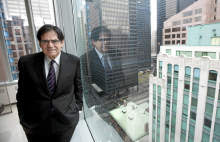The key goal for OMERS in coming years is to shift its asset mix so that half its assets are invested in the private market, in areas such as infrastructure, real estate and private equity, with the rest in public market investments such as stocks and bonds. The pension fund’s desire to make this change was heightened by the financial crisis, which wreaked havoc on public markets.
The most recent figures, as of Dec. 31, 2009, show that more than 60 per cent of OMERS’ $48.4-billion of assets was invested in public markets.
Mr. Nobrega’s challenge is compounded by OMERS’ brisk growth. “We can probably organically grow this pension plan in five years to about $70-billion to $80-billion,” he said in a recent interview in his Toronto office.
The upshot is that the plan will have a short period in which to find attractive opportunities for a large amount of capital, at a point in the financial cycle when the competition is fierce for good opportunities in areas such as infrastructure.
While it shifts its asset mix, the fund is also looking for more control. OMERS wants to ramp up the proportion of its investments that it actively manages, seeking control when it invests its money.
As a result, it has been creating new beachheads. It opened an office in London (just as stock markets collapsed in late 2008) and it’s now fully staffed with 20 employees, including specialists in real estate, infrastructure, private equity and capital markets. OMERS has since set up an interim office in New York, which will become a permanent fixture this spring. It intends to open an office in Asia at some point.
“It’s best to have people on the ground to understand the opportunities,” Mr. Nobrega said. “We have begun to find that the investments flowing through the U.K. are much higher now, those opportunities are coming to us.”
Part of the goal is to find large world-class partners in new markets, because the opportunities that OMERS is most attracted to – such as large infrastructure projects – are often too big for it to bite off alone. In November, its infrastructure arm, Borealis Infrastructure, teamed with the Ontario Teachers’ Pension Plan to buy the rights to run High Speed One, Britain’s only high-speed rail line, for about $3.4-billion.
New offices should also help OMERS reach another goal: invest more of its assets outside Canada. Currently, about 65 per cent of its portfolio is deployed here. “We want to move more toward 50,” Mr. Nobrega said. “When you get major partners around the world, U.K. pension funds and U.S. pension funds, you’ve got to be reciprocal and make sure you invest in some of their markets too.”
Ontario remains the plan’s largest geographical exposure. But it’s increasingly placing investment dollars in Alberta. “I’m very bullish on Alberta,” Mr. Nobrega said. “The West is getting very strong, and people in Central Canada have to recognize the fact that the power is shifting to the West, because their finances are much better.”
 Tara Perkins of the Globe and Mail reports, OMERS eyes shift into private market:
Tara Perkins of the Globe and Mail reports, OMERS eyes shift into private market:
Comments
Post a Comment